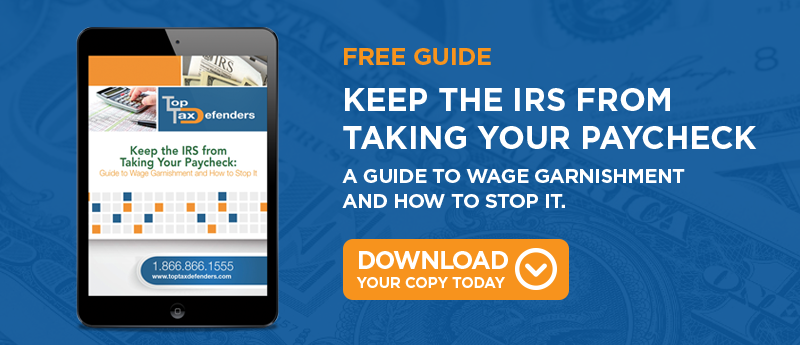.png?width=2000&height=1301&name=Untitled%20design%20(41).png)
Experiencing a wage garnishment can be an unsettling and stressful situation. If you've recently received notice that the Internal Revenue Service (IRS) or another government agency plans to garnish your wages to collect unpaid taxes or other debts, you're not alone in feeling concerned or confused about what happens next. Wage garnishment is a significant financial challenge, and it's entirely normal to have questions and worries about the process, its implications, and how to navigate through it. Below, we'll provide you with information to help you better understand what wage garnishment entails, your rights and options, and steps you can take to address this situation and regain control of your financial well-being. If you still have questions, check out part 2 of our wage garnishment FAQs.
How Do Wage Garnishments Work?
An IRS wage garnishment, also known as a wage levy, is a legal process by which the Internal Revenue Service (IRS) can collect unpaid federal taxes directly from a taxpayer's wages or salary. Wage garnishment is a method employed by the IRS to enforce tax collection when a taxpayer has outstanding tax debt and has not made arrangements to pay it. Here's how it works:
- Notice of Intent: Before the IRS can initiate wage garnishment, they are required to send you a notice called a "Notice of Intent to Levy." This notice informs you of the IRS's intention to garnish your wages unless you take appropriate action to resolve your tax debt.
- Opportunity to Respond: After receiving the notice, you have the right to respond, typically within 30 days. You can either pay the debt in full, set up a payment plan, or propose an alternative resolution, such as an Offer in Compromise.
- Final Notice of Intent: If you don't respond or fail to make arrangements to resolve the tax debt, the IRS will send a Final Notice of Intent to Levy.
- Wage Garnishment: Once the Final Notice has been sent, the IRS can contact your employer and instruct them to withhold a portion of your wages to cover the unpaid tax debt. The employer is legally obligated to comply with the IRS's instructions.
How Much of My Wages Can Be Garnished?
The amount garnished from your wages depends on various factors, including your filing status, number of dependents, and standard deductions. The IRS will generally leave you with a certain minimum income needed to cover your basic living expenses.
Wage garnishment is a serious step in the tax collection process and can have a significant impact on your financial well-being. Because of this, you should address tax issues promptly and communicate with the IRS to explore options for resolving the debt, such as setting up a payment plan, making an Offer in Compromise, or requesting a temporary delay in collection until your financial situation improves.
Keep in mind that tax laws and procedures may change over time, so it's advisable to consult with a tax professional or attorney for specific guidance and advice if you are facing IRS wage garnishment or have tax debt issues.
Types of Garnishments
If you have outstanding tax debt, the IRS may employ various types of garnishments to collect the outstanding amount. Here are the main types of IRS garnishments:
Wage Garnishment (Wage Levy):
This is the most common type of IRS garnishment. With a wage levy, the IRS instructs your employer to withhold a portion of your wages to satisfy the unpaid tax debt.
Bank Levy:
A bank levy is a one-time freeze by the IRS on the funds in your bank account. The bank is required to freeze the funds in the account for 21 days before the amount owed is withdrawn and sent to the IRS debt settlement.
What Are My Wage Garnishment Rights?
When your wages are garnished or bank accounts frozen by the IRS, your employer is directed to seize your assets (typically wages) for the IRS’s settlement of your tax debt. The IRS does not need a court order to garnish your wages, and your employer cannot fire you because of a wage garnishment order. Tax debts may be collected for up to 10 years after the date the tax bill was assessed, but the IRS has different ways of determining when that time begins and ends. Because it is not uncommon for a judgment to be enforced even when it is close to the 10-year mark, you’re better off resolving owed debts sooner rather than later.
What Are My Options?
If you are subject to a garnishment, you have several options that may be used in various combinations, depending on your specific circumstances.
File for Collection Due Process
Filing for a Collection Due Process (CDP) hearing when facing a wage garnishment means you're requesting the opportunity to challenge the garnishment with the IRS before it proceeds, presenting your case and potentially exploring alternatives or resolving the issue. This can buy you a little more time to work out a plan.
Fight in Court
Are you able to prove legal eligibility for a change or reversal of the judgment? To challenge a wage garnishment in court, you'll need to request a hearing where you can present your case. In this hearing, you should prepare a strong defense that could include evidence of financial hardship, errors in the IRS's calculations, or compliance with a tax resolution plan. When you attend the hearing, you can present your case, and if the court rules in your favor, the garnishment may be reduced or lifted. Consulting with a tax attorney for professional guidance and assistance can be very helpful, as the legal process and IRS regulations can be intricate and challenging to navigate.
Negotiate
Through negotiation with the IRS, you can agree to a payment plan with set monthly payments occurring each month. These monthly payments are usually lower than the garnishment amount and possibly at a lower settlement amount on your tax debt. This means you could be done paying off your debt sooner. An experienced negotiator, like Top Tax Defenders, can guide you through this process and offer expertise in achieving a successful resolution.
Apply for Not Collectible Status
For taxpayers who legitimately do not earn enough income or those who have excessive expenses that prevent them from settling their account with the IRS, you can apply for “Currently Not Collectible” status.
Can the IRS Seize My Assets?
Though technically it is possible for the IRS to seize your assets, property seizure is not typically the first way the IRS will try to settle a tax debt. Wage garnishments and bank account levies will typically be enacted before asset seizure. However, additional actions may be taken if you don't take steps to address your tax debt and make arrangements with the IRS. If you are subject to a garnishment, you should quickly explore options to resolve your tax issues promptly.
Can I Be Subject to Multiple Garnishments at Once?
Whether or not you can have multiple wage garnishments at once depends more on how much you owe than how many creditors you owe. The total amount garnished cannot exceed the percentage allowed by federal law. This means that usually only one creditor can garnish your wages at a time, and it’s typically the creditor who files for a garnishment order first. Additional creditors may also be granted a garnishment order if the amount taken by the first creditor is lower than the percentage allowed by law. But the total amount garnished by all creditors cannot exceed the legally allowed percentage of your assets or wages.
Conclusion
In conclusion, experiencing a wage garnishment can be a daunting and overwhelming experience, but it's essential to remember that there are ways to address and resolve your tax debt problem. Seeking additional help, whether from a tax professional, attorney, or financial advisor, like Top Tax Defenders, can make a significant difference in navigating this complex process. Don't hesitate to reach out for assistance; tax experts can provide you with valuable insights, explore potential options such as installment plans, offers in compromise, or other options suited to your specific circumstances, and help you regain control of your financial situation. Remember, you are not alone! There are resources available to help you overcome this challenge and move towards a more stable and secure financial future.




